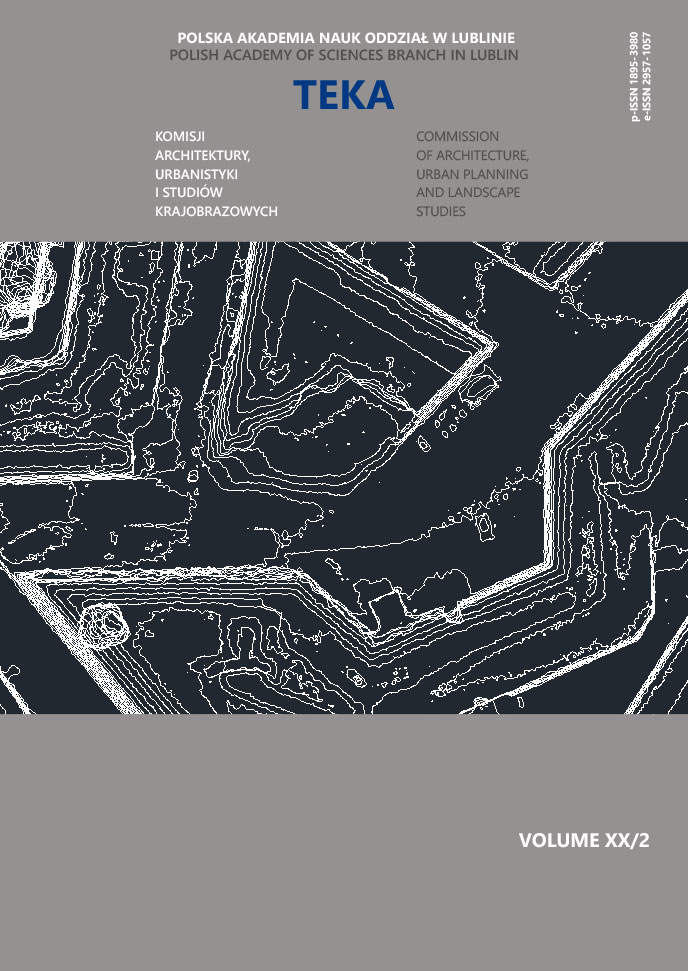Children's painting as a tool for communicating needs and values in terms of spatial planning
Article Sidebar
Open full text
Issue Vol. 20 No. 2 (2024)
-
Research issues of church architecture on the eastern borderlands of Poland
Kostiantyn Pinkovskyi, Jan Wrana7-13
-
Children's painting as a tool for communicating needs and values in terms of spatial planning
Aleksandra Sztorc, Jagoda Wawszczak, Paweł Wiśniewski14-22
-
Innovative Architectural Learning: A Case Study on Multidisciplinary and Experiential Teaching Methods
Luis Moreira Pinto, Muhammet Emin Guner23-41
-
Pavilion of the Lusatian Culture Archaeological Reserve in Częstochowa-Raków – a Case Study
Emilia Malec-Zięba42-50
-
Seasonality in the Design of the Environment of a Hotel Facility on the Example of the Rest House for Employees of Lublin University of Technology in Kazimierz Dolny
Damian Hołownia, Dominika Lisiewska51-61
-
Optimal parking solutions in a limited space: analysis for the area around the Rest House for Employees of Lublin University of Technology in Kazimierz Dolny
Aleksandra Sztorc, Aleksandra Typek62-72
-
Dialogue between history and modernity in the preservation of historical ruins: The case of Helfštýn Castle
Katarzyna Drobek, Tetyana Kashchenko73-88
Archives
-
Vol. 20 No. 3
2024-12-27 7
-
Vol. 20 No. 2
2024-12-27 7
-
Vol. 20 No. 1
2024-12-27 8
-
Vol. 19 No. 2
2023-12-29 11
-
Vol. 19 No. 1
2023-12-19 13
-
Vol. 18 No. 4
2022-12-30 5
-
Vol. 18 No. 3
2022-12-27 5
-
Vol. 18 No. 2
2022-12-27 5
-
Vol. 18 No. 1
2022-12-27 4
-
Vol. 17 No. 4
2021-12-30 11
-
Vol. 17 No. 3
2021-12-30 9
-
Vol. 17 No. 2
2021-12-30 8
-
Vol. 17 No. 1
2021-12-30 8
-
Vol. 16 No. 4
2020-12-30 11
-
Vol. 16 No. 3
2020-09-30 10
-
Vol. 16 No. 2
2020-06-30 11
-
Vol. 16 No. 1
2020-03-31 10
Main Article Content
DOI
Authors
Abstract
The article undertakes an analysis of drawings by children aged 5-6 years as an important source of knowledge about the perception of living space and basic needs that can be used in the architectural design process. The study, carried out in the form of art workshops, revealed that the children's artwork focused on key elements.
The children's work was characterised by simplified forms, indicating their natural tendency to prioritise function over decorativeness. This approach can provide valuable inspiration for designers aiming to create more welcoming and intuitive spaces. The authors emphasise that children's representations of space can not only support the development of minimalist and functional architectural solutions, but also address the emotional needs of users.
The article emphasises the potential of children's imagination as a source of innovative spatial solutions and points to the need to extend the research, both in terms of the diversity of participants and cultural context. Complementing the research with comparisons between different age groups or regions could provide even more diverse and practical conclusions for human-centred architecture.
Keywords:
References
Duksa, P. (2011). Rysunek dziecka w diagnozie psychopedagogicznej. Studia Elbląskie, 12, 425−435.
Fabris, M.A., Lange-Küttner, C., Shiakou, M., & Longobardi, C. (2023). Editorial: Children’s drawings: evidence-based research and practice. Frontiers in Psychology, 14. https://doi.org/10.3389/fpsyg.2023.1250556. DOI: https://doi.org/10.3389/fpsyg.2023.1250556
Gernhardt, A., Rübeling, H., & Keller, H. (2013). “This Is My Family” Differences in Children’s Family Drawings Across Cultures. Journal of Cross-Cultural Psychology, 44. DOI: https://doi.org/10.1177/0022022113478658
Krasoń, K. (2015). Pomaluj mnie na czerwono-niebiesko: O barwach w optyce dziecięcej. Chowanna, 2(45), 133–159.
Lami, I.M., & Mecca, B. (2021). Assessing Social Sustainability for Achieving Sustainable Architecture. Sustainability, 13(1), Article 1. https://doi.org/10.3390/su13010142. DOI: https://doi.org/10.3390/su13010142
Olaoye, G., & Abdallah-Tani, K. (2024). Symbolism and Meaning in Children’s Drawings within the Context of Contemporary art. 2, 290–317.
Said, I. (2007). Architecture for Children: Understanding Children Perception towards Built Environment.
Spence, C. (2020). Senses of place: Architectural design for the multisensory mind. Cognitive Research: Principles and Implications, 5(1), 46. https://doi.org/10.1186/s41235-020-00243-4. DOI: https://doi.org/10.1186/s41235-020-00243-4
Article Details
Abstract views: 134



